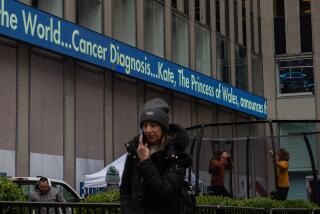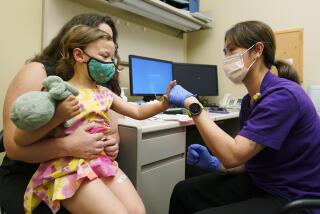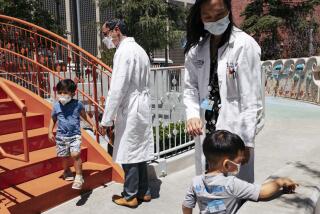Giving Parents a Dose of Confidence
- Share via
Fior Abrego was the kind of mother who would rush her children to the hospital and spend hours waiting for a doctor to treat their minor ailments, even the sniffles, that she could have handled herself.
But that was before she received an easy-to-read medical reference manual, participated in a training session and became savvier in the art of caring for her children.
“It’s like having your doctor at the house,” Abrego, 32, said of the 187-page book, What to Do When Your Child Gets Sick.
The UCLA/Johnson & Johnson Health Care Institute launched the program in 2001, distributing the manual to 1,600 families nationwide. The results among those receiving the book were dramatic: Emergency room trips were cut by nearly half and clinic visits dropped more than a third.
That, in turn, led to a significant drop in the number of days parents missed work and students were kept out of school, the study’s researchers said.
“The aim is to help these parents not panic, to make them have a sense of healthcare, and make them feel they are the first line of defense in taking care of their children’s health,” said Ariella Herman, a senior lecturer at the UCLA Anderson School of Management and the study’s lead investigator. “I’m not saying these parents are totally health-literate after the program, but it’s a start. They are more confident.”
The institute hopes to train 12,000 more families nationwide by 2005 in simple healthcare techniques, focusing primarily on treating children up to age 5. Most of the parents are covered by Medicaid -- known as Medi-Cal in California -- and participate in Head Start and Early Head Start, comprehensive government-funded programs to prepare children from low-income families for school.
Medicaid could save up to $2.4 million a year in direct costs associated with needless visits to hospitals and clinics after the nationwide training is completed, researchers estimate.
Abrego, a single mother and freshman studying early childhood development at Pasadena City College, said the book provided a “hint of what might be happening with the child.”
Now, she said, she has a better idea of what to do when one of her girls -- ages 3 and 9 -- becomes sick: take the child’s temperature, give a warm bath or administer some over-the-counter medication. If that didn’t help, she said, only then would she consider seeing a doctor.
What to Do When Your Child Gets Sick, published in English and Spanish, uses simple terms and illustrations. It offers straightforward explanations for more than 50 common childhood ailments, such as coughs, fever, diaper rash, colic and diarrhea.
“It’s doctors’ talk oversimplified and user-friendly,” said Wassy Tesfa, administrator for Head Start programs in Glendale and Pasadena. “And if [parents] call the doctor, they call more informed if they have read the book.”
Tesfa said about 40% of the parents in her program’s coverage area were immigrants, many from South America, Asia and Armenia. Often unable to read English well enough to consult medical manuals -- or speak it enough to call a service provider and hear perhaps a simple solution to a child’s illness -- many view a hospital or clinic as their only line of defense.
“Because I couldn’t read English, I didn’t know exactly how much medicine to give my baby,” said Elsa Aragon, 30, a mother of two who emigrated from Mexico six years ago. “The book taught me what measurements are needed.”
It also taught her how to use a thermometer and at what temperature she should become concerned. She learned that preventing water from getting into her son’s ears while bathing him could help keep him from getting earaches.
And when her daughter’s navel became slightly inflamed shortly after birth, Aragon consulted the book. It explained that such symptoms were typical and that, unless they got worse, she should keep the area dry, clean it with alcohol and take care not to let the baby’s diaper rub against it.
“Now I don’t go to the doctor for just any reason,” Aragon said. “I try to solve the problem at home first.”
Many parents agreed that having access to the guide and avoiding constant trips to the emergency room or clinic had saved time and money.
“Sometimes you could be there for four to five hours, just for them to give your child a Tylenol,” said Sylvia Flores, 22, a single mother of a 4-year-old boy. “It’s really frustrating, a waste of time.”
“Having the book has given me more confidence,” she said. “I’ve read it six times and I always go back to it.”







